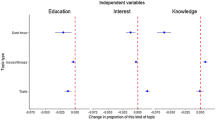Abstract
The 1980 and 1982 American national election studies include a new series of questions about individual partisanship. It is possible to create a 5-point scale of party support/closeness from these questions. The new measure performs reasonably as regards its relationship to other measures of partisanship, to its own continuity over time, and to dependent behavior. There is also a new question on independence, but this is best treated as a separate item rather than being incorporated in the party support/closeness scale. The new measure also performs well in measuring strength of partisanship.
Similar content being viewed by others
References
Blalock, Hubert M. (1970). “Estimating Measurement Error Using Multiple Indicators and Several Points in Time.”American Sociological Review 35:101–111.
Dennis, Jack (1981a). “On Being an Independent Partisan Supporter.” Paper presented at the 1981 Annual Meeting of the Midwest Political Science Association, Cincinnati, Ohio.
Dennis, Jack (1981b). “Some Properties of Partisanship.” Paper presented at the 1981 Annual Meeting of the American Political Science Association, New York City, New York.
Dennis, Jack (1982). “New Measures of Partisanship in Models of Voting.” Paper presented at the 1982 Annual Meeting of the Midwest Political Science Association, Milwaukee, Wisconsin.
Heise, David R. (1971). “Separating Reliability and Stability in Test-Retest Correlation.” In Hubert M. Blalock (ed.),Causal Models in the Social Sciences. Chicago: Aldine, pp. 348–3633.
Miller, Arthur H., and Martin P. Wattenberg (1983). “Measuring Party Identification: Independent or No Partisan Preference?”American Journal of Political Science 27:106–121.
Petrocik, John R. (1974). “An Analysis of Intransitivities in the Index of Party Identification.”Political Methodology 1:31–47.
Sullivan, John L., and Stanley Feldman (1979).Multiple Indicators. Sage University Paper series on Quantitative Applications in the Social Sciences. Beverly-Hills and London: Sage Publications.
Weisberg, Herbert F. (1980). “A Multidimensional Conceptualization of Party Identification.”Political Behavior 2:33–60.
Weisberg, Herbert F. (1982). “Party Evaluations: A Theory of Separate Effects.” Paper presented at the 1982 Annual Meeting of the Midwest Political Science Association, Milwaukee, Wisconsin.
Author information
Authors and Affiliations
Rights and permissions
About this article
Cite this article
Weisberg, H.F. A new scale of partisanship. Polit Behav 5, 363–376 (1983). https://doi.org/10.1007/BF00987561
Issue Date:
DOI: https://doi.org/10.1007/BF00987561




